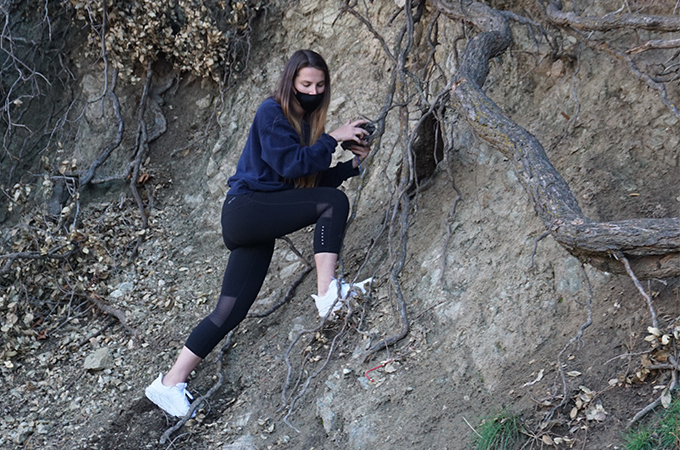When University of Redlands students reviewed the images dispatched from cameras they recently mounted in a local forest, they were both surprised and delighted at what they saw: a blonde bear and a cinnamon bear.
“I knew that black bears, the only species of bear in California, could be blonde, but I had certainly never seen one before,” says U of R ecologist Wendy McIntyre, who holds the Hedco Chair for Environmental Studies and whose current research examines mammal population movements in the San Bernardino Mountains. “The cinnamon bear was a reddish-brown, and we know they are both adult male bears because they were so large. Having different-colored hair is pretty unusual.”
In February and March, McIntyre and 12 undergraduate students in her Ecology for Environmental Scientists course traveled up to the Wildland Conservancy’s Bearpaw Reserve in Forest Falls, about 20 miles from the University’s Redlands campus, to install new, high-quality, wildlife motion-detector cameras. Funding for the cameras, which capture multiple 10-second color videos with sound, was provided by several faculty research and teaching technology grants to McIntyre.
“You can see a lot of detail on the animals, like a scar, or different coloration patterns,” says McIntyre of the new cameras. “We can distinguish individual bears at this point, including the blonde and cinnamon bears.”
Fire sparks change in focus
Images of animal activity have been gathered by both still and video cameras, strapped to trees and roots with bungee cords, for about four years under McIntyre’s guidance. The data collected contributes to the multi-year research conducted by the students and the professor as they try to understand how the hubbub of humans at the nearby Thurman Flats Picnic Area affects animal activity.
McIntyre’s students have visited Bearpaw and tracked the bears, an occasional mountain lion, bobcats, fox, deer, raccoons, a rare coyote, the elusive ringtail, and lots of squirrels, chipmunks, packrats, and birds. Summer Science Research students have also created a series of posters using geographic information systems data to establish the location and range of animal activity.
Anna Jones ’21, who is graduating with a bachelor’s degree in environmental science and planning a career as a field biologist, explains her senior capstone project: “I use data collected over the last couple of years to analyze the distribution and behavior of the bears in the area. Being able to set up cameras, look at footage, and analyze data has been a great experience. It’s amazing to see the kind of wildlife that’s in an area so close to campus.”
Jones’s research took an unexpected turn last September when the El Dorado wildland fire burned through large parts of the preserve, she says: “We are now collecting data to see how the fire might have affected the bears’ distribution.”
The newly installed cameras are helping Jones and other students see and hear what’s changed in the last six months, but it’s too soon to have definitive answers. One of the effects of fire is a change in vegetation, and the researchers will learn which animals remain, are lost, or may have relocated, and whether different animals may be drawn to the preserve as it grows back with weedy plants replacing old-growth forest.
“What we see should be super interesting,” says McIntyre. “The Wildlands Conservancy is also really interested in our discoveries, because staff want to know what’s there and how the animals are faring.”
A pandemic pivot
Just weeks before last summer’s El Dorado fire, McIntyre retrieved cameras from the forest. She sent the equipment to 31 students in her biodiversity course, who were studying remotely due to pandemic restrictions.
“It was something they could do in a lab class when they were far from campus,” she says. “They set up the cameras in their backyards and shared what they ‘caught’ at the end of the semester.” Right now, her ecology students are also conducting backyard research with the cameras.
Because of the fire and subsequent mudslides, Bearpaw Preserve is closed to the public, but McIntyre’s student teams are welcome, with strict safety measures, to continue to install new cameras. “It’s truly a perfect research and teaching location because it’s nearby and yet so full of the wildlife that you’d expect further from the beaten path,” says McIntyre. “You can get there and do some meaningful work in an afternoon.”
Learn more about environmental studies at the University of Redlands.






